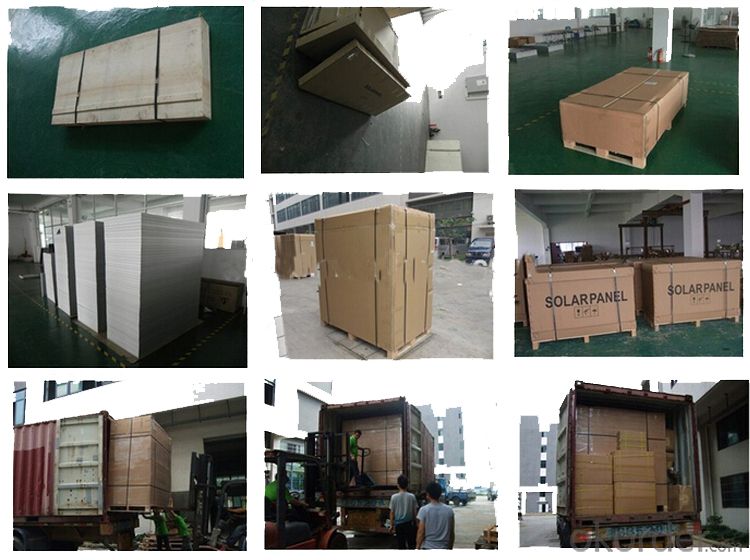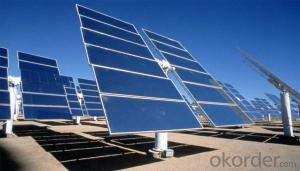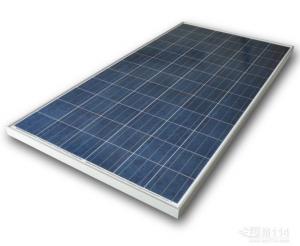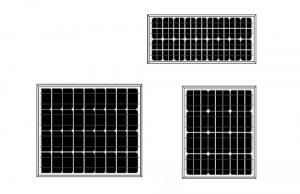CE and TUV Approved 130W Poly Solar Panels - Canada Solar Panels
- Loading Port:
- Shanghai
- Payment Terms:
- TT OR LC
- Min Order Qty:
- 10000 watt
- Supply Capability:
- 20000000 watt/month
OKorder Service Pledge
OKorder Financial Service
You Might Also Like
Specification
1. The Introduction of Solar Module
Solar modules use light energy from the sun to generate electricity through the photovoltaic effect. The majority of modules use wafer-based crystalline silicon cells or thin-film cells based on cadmium telluride or silicon. The structural (load carrying) member of a module can either be the top layer or the back layer. Cells must also be protected from mechanical damage and moisture. Most solar modules are rigid, but semi-flexible ones are available, based on thin-film cells.
2.Technical Parameter
Type | CNBM Solar Polycrystalline Series |
Materials | Silicon |
Guarantee | 12 yrs free from defects in materials and workmanship No less than 90% within 10yrs and no less than 80% within 25yrs TUV(IEC61215&IEC61730), CE, UL |
Application | Photovoltaic/ solar/ green energy/ energy saving |
Descriptions | 1.High efficiency crystalline silicon solar cell. Even if under the weak light, the solar module can produce maximum power output. 2.Tempered glass (toughened glass): Anti-reflecting coating and high transmission rate glass increase the power output and mechanical strength of solar module. 3. EVA and TPT: Using high quality EVA and TPT to prevent destroying and water. 4. AI frame: Without screw, rner connection. 6 holes on the frame can be installed easily. 5. Junction box: Multi function junction box with water proof. 6. Long lifetime: ≥25 years; Less power decrease. 7. Good performance of preventing from atrocious weather such as wind and hails. 8. Resisting moisture and etching effectively, not effected by geology. 9. The certificate issued by international authority: UL, TUV, IEC, CE.
|
Packaging Details: | 26pcs/pallet, 28pallets/ 40HQ Our solar panels are packed in cartons, and then pallet. Shipping by sea or by air are both ok, it up to customer’s chose. We’d like to inquiry the freight cost for customer after be informed exact quantity and destination address. |
3. Application and Pictures of Products



4. How to Work

5. Packing Details

6. FAQ
Q1: What is the business type for the company?
A1: We are one of the biggest manufacturers in zhejiang.Chnia. Which is a high tech PV enterprise dedicated to the research, development, production and sales..
Q2: How long solar panel warranty can you offer?
A2: 10-Year product warranty,25-year linear power output warranty
If there is any quality problem, we will pay for freight and send free parts to you.
Q3: How many certificates do you have?
A3: We have 16 certificates,such as CE, TUV, UL, and so on.
- Q: Can solar panels be installed on a golf course or clubhouse?
- Yes, solar panels can be installed on a golf course or clubhouse. The large open spaces and ample sunlight make it an ideal location for harnessing solar energy. Installing solar panels can help generate clean and sustainable electricity, reducing reliance on traditional power sources and potentially lowering energy costs for the golf course or clubhouse.
- Q: Ok so i can have a problem i have two 5 watt 2 volt solar panels a 2 volt battery and a 400 watt ac 2 volt dc inverter i believe im only getting 5 watts from from my solar panels thats the equivalent of one is there any way i could get full voltage from my solar panels without theoretically burning my wallet.. please help
- I think you need to take some basic courses on electricity. Usually, 8 volt solar panels are required to charge 2 volt batteries. The voltages of photovoltaic cells are set by the material they are made of, only current changes. If you hook up a 2 V solar panel to a 2 V battery, no current will flow, nothing would get charged. You would need some elaborate DC to DC voltage converters to charge a 2 V battery from 2 V solar panels. Solar panels can be connected in parallel or in series, as you've made the mistake of buying 2 V solar panel, you would have to wire them in series and have a charge controller that could limit the voltage of the charge. Did it ever occur to you that two 5 watt solar panels would not be able to provide the power needed by a 400 watt inverter? You're just running off your battery with your set up. Solar power is expensive power, you can not have solar without burning a hole in your wallet.
- Q: Single crystal solar panels and polycrystalline solar panels
- Monocrystalline silicon solar cells are mainly made of monocrystalline silicon, compared with other types of solar cells, monocrystalline silicon cell conversion efficiency of the highest. In the early days, monocrystalline silicon solar cells occupied most of the market share, in 1998 after the retreat of polysilicon, the market share accounted for second. Due to the shortage of polysilicon raw materials in recent years, after 2004,
- Q: The first solar panel that creates energy from UV rays... who created it
- The first photovoltaic cell was developed at Bell Labs in 954. The team included G.L. Pearson, C.S. Fuller, and D.M. Chapin. A panel is composed of many cells. They respond to a wide range of wavelengths, not just UV.
- Q: Can solar panels be installed on a gas station or convenience store?
- Yes, solar panels can be installed on a gas station or convenience store. In fact, many gas stations and convenience stores have already embraced solar energy as a way to reduce their carbon footprint and lower energy costs. By installing solar panels, these establishments can generate renewable electricity and potentially even sell excess power back to the grid.
- Q: This is for my science project and i cannot figure it outWe assumed that blue light shining on a solar panel would give off the higher volt reading because it has the shortest wavelength and the highest energy, but it was actually the lowest. Why does this happen? Im very confused And cant find the answer anywhere.... ,thank you!!
- Surely the highest volt reading will result from the wave with the largest amplitude, wavelength irrespective? You'd need to know the amplitude of the wave AFTER leaving the colour filter, since different chemicals and pigments in the filter would naturally affect the resulting wave in different ways.
- Q: Can solar panels be used in remote areas with no access to the grid?
- Yes, solar panels can be used in remote areas with no access to the grid. Since solar panels generate electricity from sunlight, they can provide a reliable and sustainable source of power in off-grid locations. By harnessing the energy of the sun, solar panels can charge batteries or directly power electrical devices, making them an ideal solution for remote areas without access to the traditional power grid.
- Q: Can solar panels be installed on mobile homes?
- Yes, solar panels can be installed on mobile homes.
- Q: What's your opinion on solar power? More specifically, having panels installed on your roof to reduce your electric bill. I'm having a consultation tomorrow to get more details. I live in the SW, so it's always crazy sunny here. I don't know what the cost will be yet. Is it something you'd consider if the situation was right? If not, why?
- Just had them installed on a development of 4 homes and they look goood! So far each user has free electricity during daytime for 3/4 of the year. If you live in a hot country - that's free A/C to keep you cool. The downside is that it is grid-tied so there is no storage, which means that if you use electricity to cook the evening meal - you don't get that free. What we advise to do instead is to make use of slow cookers that cook meals during the day - for FREE, and just serve it up in the evening as it keeps the heat. It would be more effective if you used storage radiators and heated hot water tanks for washing/bathing using it but this hasn't been added yet. It's free power all day - so what is there to complain about? The only catch I have found is that some power companies charge YOU if you export power to the grid - so just watch out for that, and design your system to avoid this if this applies, but most just don't pay anything - so you may as well use what you get.
- Q: im trying to experiment with solar panels. so i dont want to buy a huge expensive solar panel if i dont need one.
- Create okorder
Send your message to us
CE and TUV Approved 130W Poly Solar Panels - Canada Solar Panels
- Loading Port:
- Shanghai
- Payment Terms:
- TT OR LC
- Min Order Qty:
- 10000 watt
- Supply Capability:
- 20000000 watt/month
OKorder Service Pledge
OKorder Financial Service
Similar products
Hot products
Hot Searches


























